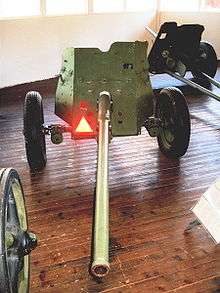45 mm anti-tank gun M1942 (M-42)
| 45-mm anti-tank gun model 1942 года (М-42) | |
|---|---|
_Museum_on_Sapun_Mountain_Sevastopol_1.jpg) M-42 in Museum on Sapun Mountain, Sevastopol. | |
| Type | Anti-tank gun |
| Place of origin | USSR |
| Service history | |
| Used by |
USSR Warsaw Pact North Korea[1] |
| Wars |
World War II Korean War[1] |
| Production history | |
| Designer | No. 172 Plant |
| Manufacturer | Artillery Plant #172, at Perm |
| Produced | 1942-1945 |
| No. built | 10,843 |
| Specifications | |
| Weight |
combat: 625 kg (1,378 lbs) travel: 1,250 kg (2,756 lbs) |
| Barrel length | 3.09 m (10 ft 2 in) 66 calibers[1] |
| Width | 1.6 m (5 ft 3 in)[1] |
| Height | 1.2 m (3 ft 11 in)[1] |
| Crew | 6[1] |
|
| |
| Shell | Fixed QF 45x386 mm. SR[1] |
| Caliber | 45 mm/ 68 (1.77 in) |
| Breech | Semi-automatic vertical sliding wedge[1] |
| Recoil | Hydro-spring[1] |
| Carriage | Split trail |
| Elevation | -8° to 25° |
| Traverse | 60° |
| Rate of fire | 15-20 rounds per minute |
| Muzzle velocity | 870 m/s (2,854 ft/s) |
| Maximum firing range | 4.55 km (2.84 mi) |
M-42 was a 45-mm Soviet light semi-automatic anti-tank gun. Its full official name is 45-mm anti-tank gun model 1942 (M-42) (Russian: 45-мм противотанковая пушка образца 1942 года (М-42)). These guns were used from 1942 until the end of World War II.
History

The M-42 was developed by the No. 172 Plant in Motovilikha as an upgrade of the 45 mm anti-tank gun M1937 (53-K). The gun received a longer barrel (L66, 20 calibers more than the previous one, so it was a 45 mm/L66), shells with more powerful cartridges, and a thicker shield (7 mm instead of 4.5 mm), but of hinged construction as a need for reduced profile, requiring crews to kneel while serving the weapon. Some minor changes were also introduced in order to speed up production.
These guns were used from 1942 until the end of World War II. In 1943, due to its insufficient anti-armor capabilities against new German tanks such as Tiger, Panther and Panzer IV Ausf H, the M-42 was partially replaced in mass production by more powerful 57 mm ZiS-2 anti-tank gun. The M-42 remained in production however, as it was quite effective against lighter vehicles and could pierce the side armour of Panther and Panzer IV Ausf H. Fragmentation shell and canister shot gave the gun some anti-personnel capability.
Mass production of M-42 ceased in mid-1945. The total number of guns produced is 10,843.
Ammunition
- Ammunition types:
- Armor-piercing
- Fragmentation
- Canister
- Smoke
- Projectile weight:
- AP: 1.43 kg (3.15 lbs)
- APCR: 0.85 kg (1.87 lbs)
- Fragmentation: 2.14 kg (4.71 lbs)
Performance
| Penetration[2] | |||||
| Type | 100 m (110 yd) | 500 m (550 yd) | 1,000 m (1,100 yd) | 1,500 m (1,600 yd) | 2,000 m (2,200 yd) |
| APBC-HE | 71 mm (2.8 in) | 54 mm (2.1 in) | 40 mm (1.6 in) | 32 mm (1.3 in) | 28 mm (1.1 in) |
| APCR | 108 mm (4.3 in) | 74 mm (2.9 in) | 46 mm (1.8 in) | - | - |
Notes
References
- Shunkov V. N. - The Weapons of the Red Army, Mn. Harvest, 1999 (Шунков В. Н. - Оружие Красной Армии. — Мн.: Харвест, 1999.) ISBN 985-433-469-4
- Koll, Christian (2009). Soviet Cannon - A Comprehensive Study of Soviet Arms and Ammunition in Calibres 12.7mm to 57mm. Austria: Koll. p. 423. ISBN 978-3-200-01445-9.
External links
| Wikimedia Commons has media related to M-42 45 mm anti-tank gun. |
- 45 mm anti-tank gun model 1942 ar rustrana.ru (in Russian)
